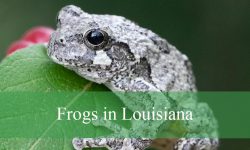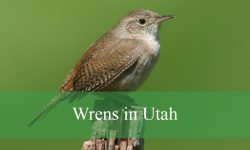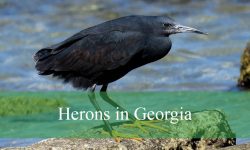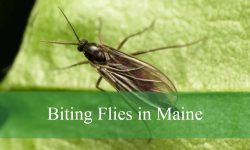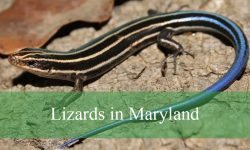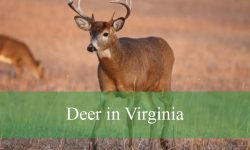Black and yellow bird species captivate birdwatchers and nature enthusiasts with their striking plumage. Their bright colors can illuminate backyard feeders or add a burst of color to fields and forests.
To fully appreciate these standout avian visitors, it’s helpful to familiarize yourself with the black and yellow bird species that frequently visit North America. While some of these species are seasonal migrants, others are present year-round.
This article will explore some of the most fascinating species with these eye-catching hues, delving into their habitats, behaviors, and unique adaptations.
Common Black and Yellow Bird Species
Wilson’s Warbler
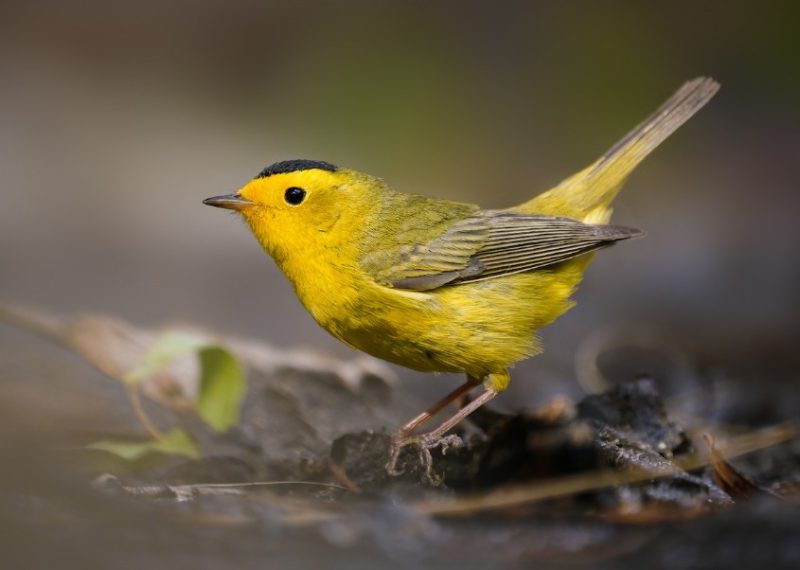
Wilson’s Warbler (Cardellina pusilla) is one of the smallest yellow and black warblers, measuring 3.9 to 4.7 inches in length with a wingspan of 5.5 to 6.7 inches and weighing 0.2 to 0.3 ounces. Males display vibrant black and yellow plumage, while females are pale greenish-yellow.
These warblers have a round body, barely noticeable neck, and long, thin tail, with a small, functional bill and darker wings. A distinctive black cap on their head adds to their unique look. Wilson’s Warblers flit through alder and willow thickets near water sources, singing melodious songs and catching insects to prepare for migration. They are constantly on the move, twitching their tails as they forage.
Western Meadowlark
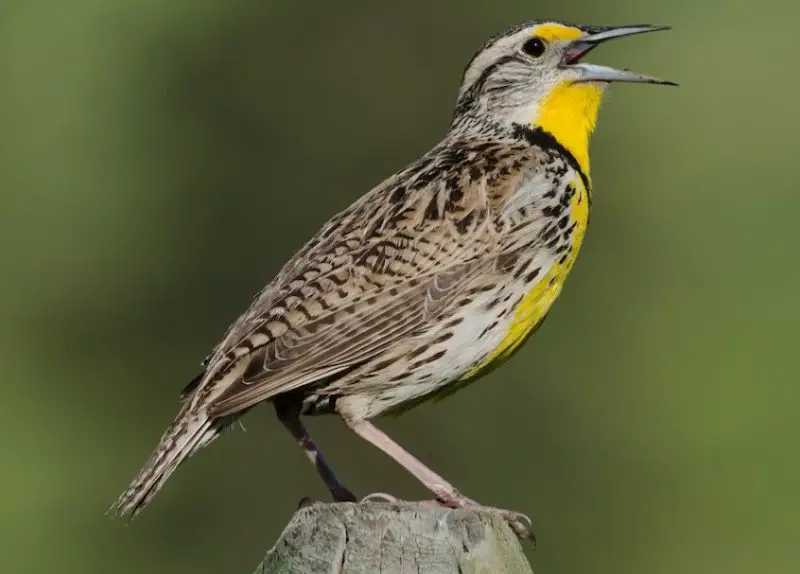
The Western Meadowlark (Sturnella neglecta) is a yellow and black bird often mistaken for the Eastern Meadowlark, but with distinct paler plumage. Measuring 6.3 to 10.2 inches in length with a wingspan of 16.1 inches and weighing 3.1 to 4.1 ounces, these birds can live up to 8 years.
They have a black and white striped head, a black V-shaped marking on the neck, brown backs and wings with black spots, and yellow underparts. Western Meadowlarks have slender bills, sharp claws, and medium-length tails.
Found in grasslands and agricultural fields, they are easy to spot in low grassy areas. They can be distinguished from Eastern Meadowlarks by their “flight song,” which is more excited compared to the Eastern’s clear, melodic whistles.
Pine Warbler
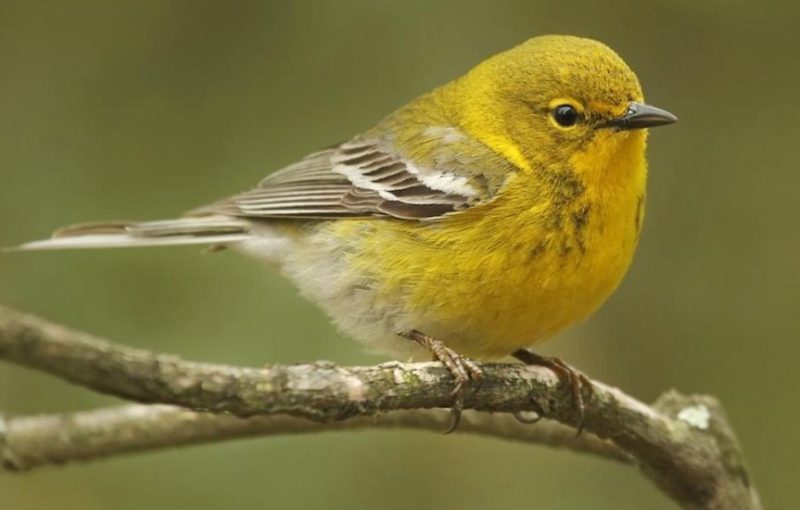
The Pine Warbler (Setophaga pinus) is a small bird with a length of 5.1 to 5.5 inches and a wingspan of 7.5 to 9.1 inches. Weighing 0.3 to 0.5 ounces and living up to 7 years, this warbler transitions from yellow and pale black hues in youth to more vivid colors in adulthood. Males have brighter plumage, while females may appear grayish.
Pine Warblers have a stocky build, stout bill, and long tail with a central notch. They reside in deciduous pine forests but may visit backyards and feeders in winter. During breeding and fall seasons, they exhibit aggressive behavior, especially towards one another.
American Yellow Warbler
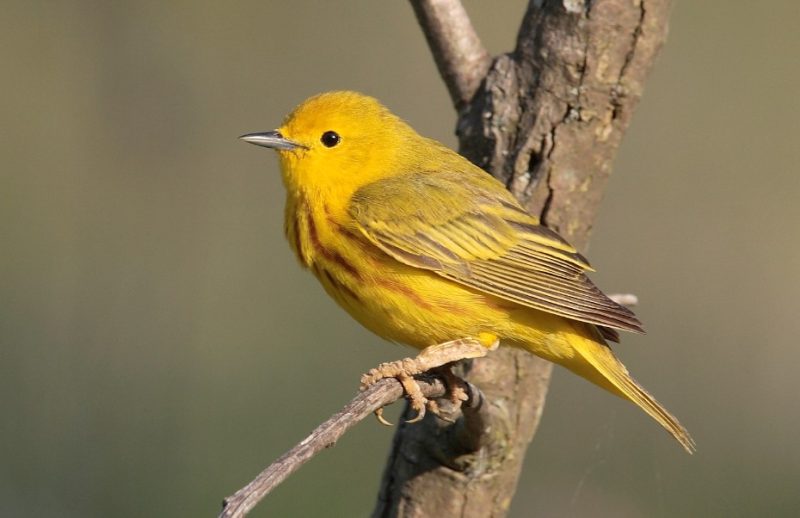
The American Yellow Warbler (Setophaga petechia) is a slender bird measuring 4.7 to 5.1 inches in length with a wingspan of 6.3 to 7.9 inches. Weighing 0.3 to 0.4 ounces and living up to 10 years, these warblers are predominantly yellow with soft black hues on their wings and tail, and reddish markings on their underparts. They have a larger, straighter, and sharper bill compared to other warblers.
Found in wetlands, woods, and shrubby thickets, their bright plumage makes them easy to spot. While they are seen in groups outside the breeding season, they become territorial during nesting. Predators include snakes, birds of prey, and foxes, leading to an annual survival rate of 30 to 60 percent.
Yellow-throated Toucan
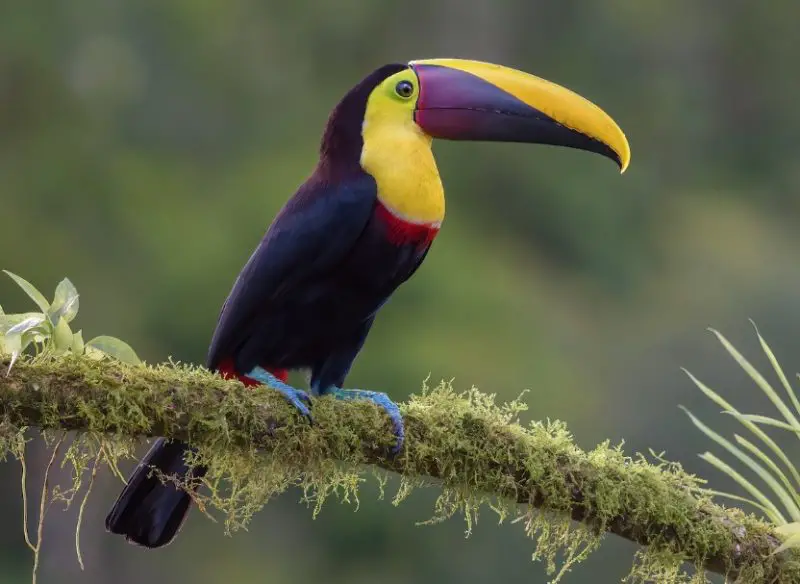
The Yellow-throated Toucan (Ramphastos ambiguus) is a strikingly large bird, measuring 18.5 to 24 inches in length with a wingspan of 43 to 60 inches and weighing 20.6 to 26.3 ounces. With a lifespan of up to 20 years, its plumage is primarily black with maroon on the hindneck and base of the beak, while the face, chest, and upper bill are vivid yellow.
Charles Darwin suggested that their massive bill may serve as a sexual lure, though it also aids in reaching fruit without relying on precarious branches. Found in tropical and subtropical forests, wetlands, and anthropogenic areas, Yellow-throated Toucans are monogamous and often seen in pairs. They can become aggressive towards other birds near their feeding trees.
Hooded Oriole
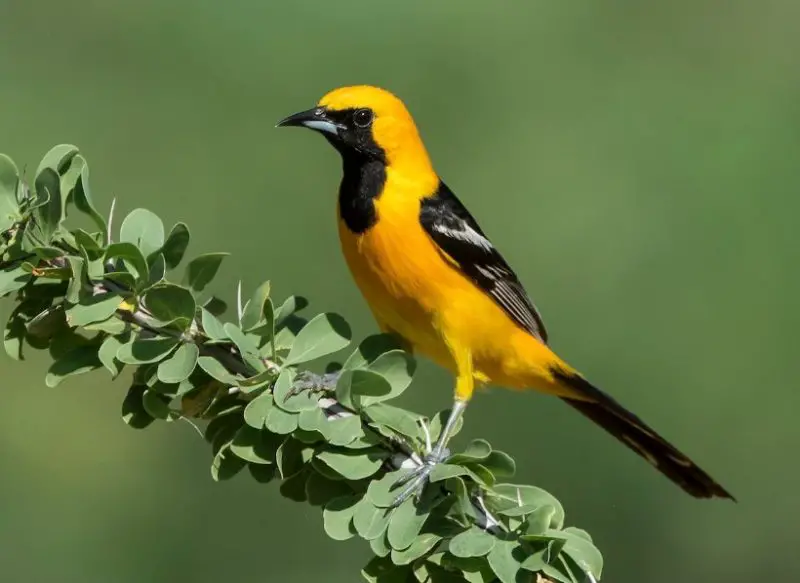
The Hooded Oriole (Icterus cucullatus) is a slender bird measuring 7.1 to 7.9 inches in length with a wingspan of 9.1 to 11.0 inches and weighing 0.8 ounces. Males have striking black plumage from the beak to the throat, including the wings, back, and tail, while their head is covered in a bright yellow hue, resembling a hood. Females are primarily yellow with pale grey wings and backs.
In South Texas and eastern Mexico, these orioles may appear yellow-orange to orange. They are known for their distinctive white wing bars and sharp, slightly curved bill. Hooded Orioles can be found in cottonwoods, palm trees, sycamores, and willows. They establish territories through vocalizations and displays, adding vibrant color to their environments.
Black-throated Green Warbler
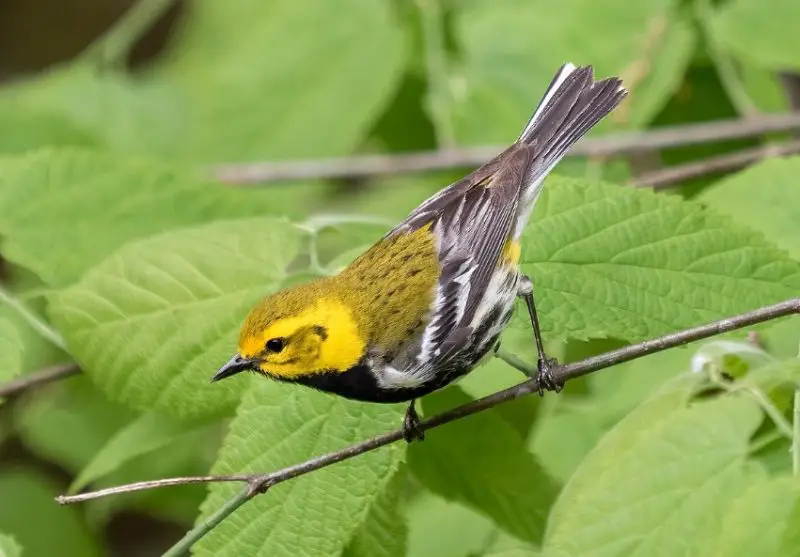
The Black-throated Green Warbler (Setophaga virens) is a small, vibrant bird measuring 4.3 to 4.7 inches in length with a wingspan of 6.7 to 7.9 inches and weighing 0.3 to 0.4 ounces. Its name reflects its striking appearance: a black throat, white underparts, and a predominantly yellow-green body. Adults exhibit a bright yellow mask around the eyes, with deeply hued black throat and wings.
These warblers are commonly found in coniferous, deciduous, and mixed forests, as well as swamps. They are highly territorial before nesting but become more social during fall and winter, joining mixed-species flocks for better survival.
Common Hill Myna

The Common Hill Myna (Gracula religiosa) is a striking bird, predominantly black with a greenish-blue iridescence and yellow accents on its face, feet, and bill. Measuring 10.6–11.8 inches long with a wingspan of 10.2–17.7 inches, it can weigh between 5.6 and 8 ounces.
This species thrives in tropical forests, plantations, and mountainous areas. Known for its remarkable mimicry, the Hill Myna’s loud calls and shrills are often heard at dawn. They can live up to 25 years and are easily identifiable by their vibrant plumage and distinctive sounds.
Magnolia Warbler
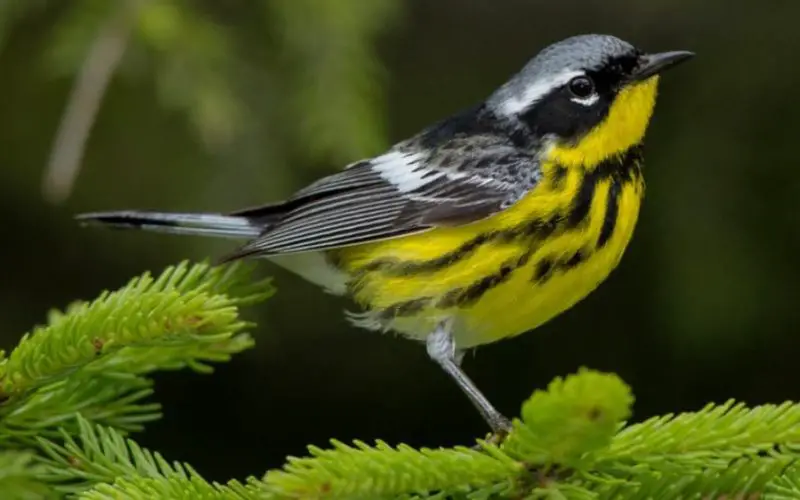
The Magnolia Warbler (Setophaga magnolia) is a small, striking bird with a length of 4.3–5.1 inches, a weight of 0.2–0.5 ounces, and a wingspan of 6.3–7.9 inches. Males are more vividly colored than females and juveniles, featuring a black eye mask, grey cap, yellow throat, and streaks of black on their chest.
During breeding season, they nest in coniferous or mixed forests, while in winter, they inhabit cacao plantations, thickets, and orchards. Known for their distinct songs at dawn and dusk, they use their white tail undersides in courtship displays.
Altamira Oriole
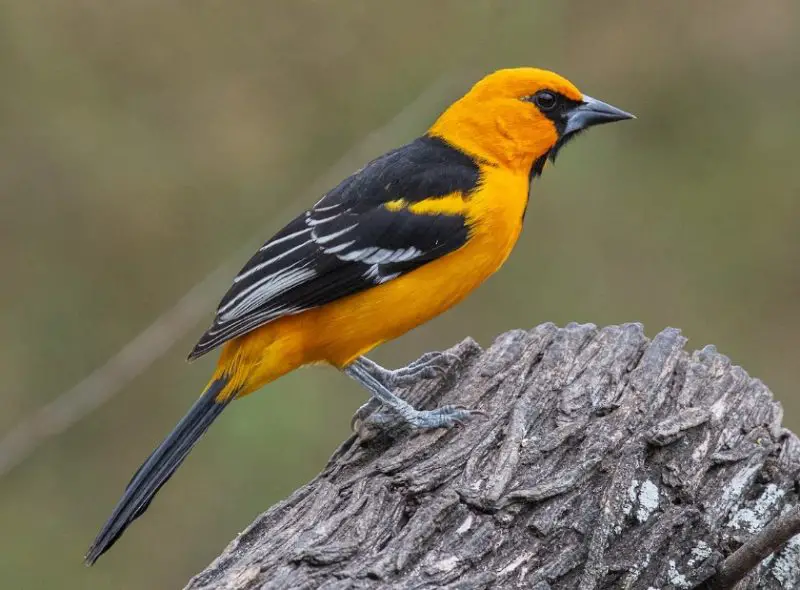
The Altamira Oriole (Icterus gularis) is a striking bird with a length of 8.3–9.8 inches, a wingspan of 14.2 inches, and a weight of between 1.7 and 2.3 ounces. Juveniles are mostly yellow, while adults feature vibrant yellowish-orange plumage with black markings around their eyes, beak, back, wings, and tail, plus white wing bars.
These birds are often seen in thorn forests, riparian zones, parks, and wooded areas, where they build nests over about three weeks. Known for their bright colors and distinctive presence, Altamira Orioles are not particularly aggressive but do vigilantly protect their nests.
Audubon’s Oriole
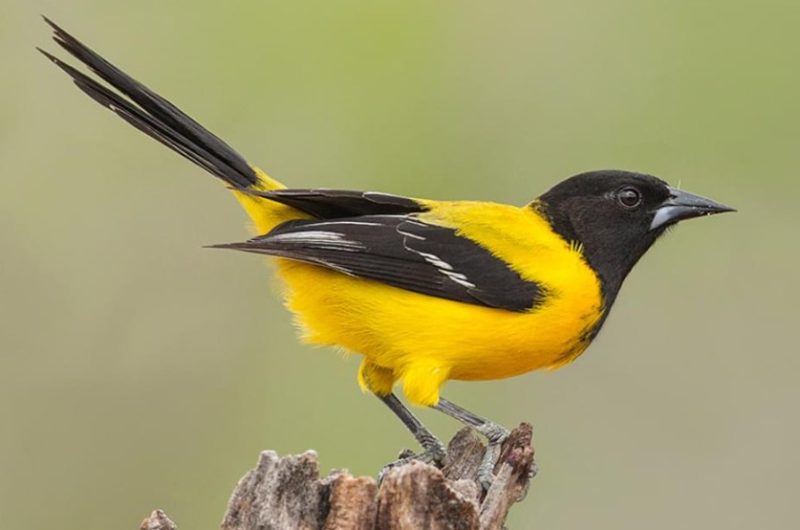
The Audubon’s Oriole (Icterus graduacauda) is a striking bird with a length of 7.5–9.4 inches and a wingspan of 12.6 inches. Weighing between 1.1 and 1.9 ounces, these yellow and black birds exhibit a black head, throat, wings, and tail, contrasting with their bright yellow body. Males display more vivid colors than females and are immature, with white edges on their wing feathers.
Typically found in thickets, woodlands, and occasionally brushy areas, Audubon’s Orioles are monogamous and forage in pairs. Despite their vibrant colors, they are often quiet and secretive, making them challenging to spot. Listening for their distinctive whistles can help locate them in their habitat.
Yellow-rumped Cacique
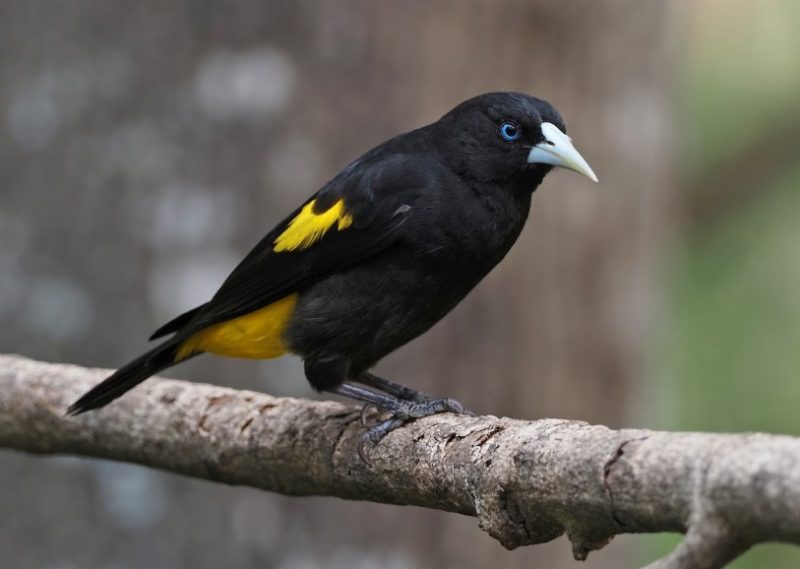
The Yellow-rumped Cacique (Cacicus cela) is a striking passerine bird known for its black and yellow plumage. Measuring 9–11.8 inches in length and weighing between 2.1 and 3.5 ounces, it features a yellow beak and blue eyes. While males are more vividly colored, females are slightly duller, and young birds initially have dark purple eyes and a brown patch beneath their bill.
These sociable birds inhabit forest edges, fields, and open areas. Their nests are often found in tree canopies, sometimes near active wasp nests. Polygynous by nature, the size of the males influences the number of female partners they attract.
Yellow-winged Blackbird
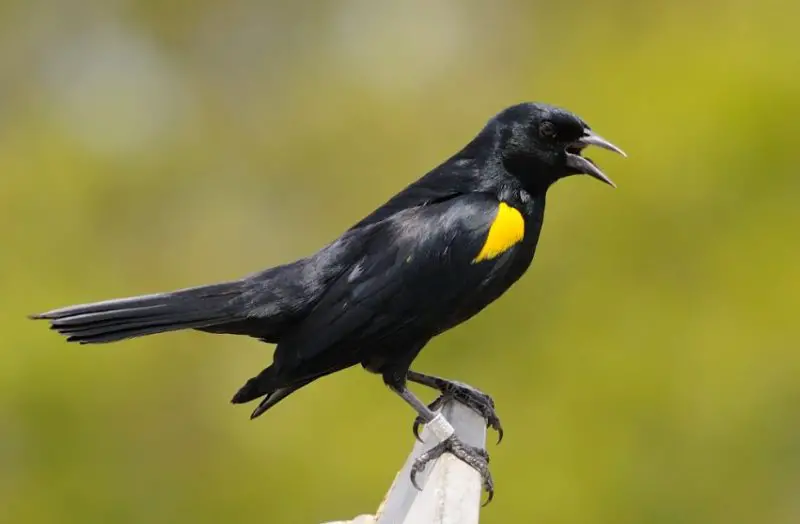
The Yellow-winged Blackbird (Agelasticus thilius) is a striking bird distinguished by its black body and vivid yellow wing base. Males sport more intense black and yellow plumage, while females are gray-mottled with black wings and yellow shoulders. Measuring 8.3–10.2 inches in length with a wingspan of 16.5–17.3 inches, these birds are typically found in freshwater wetlands, meadows, and near lakes.
Social by nature, they form small flocks and are often seen perched high in trees. The yellow wing markings are most prominent in flight, though they are partially concealed when resting.
Golden-headed Manakin
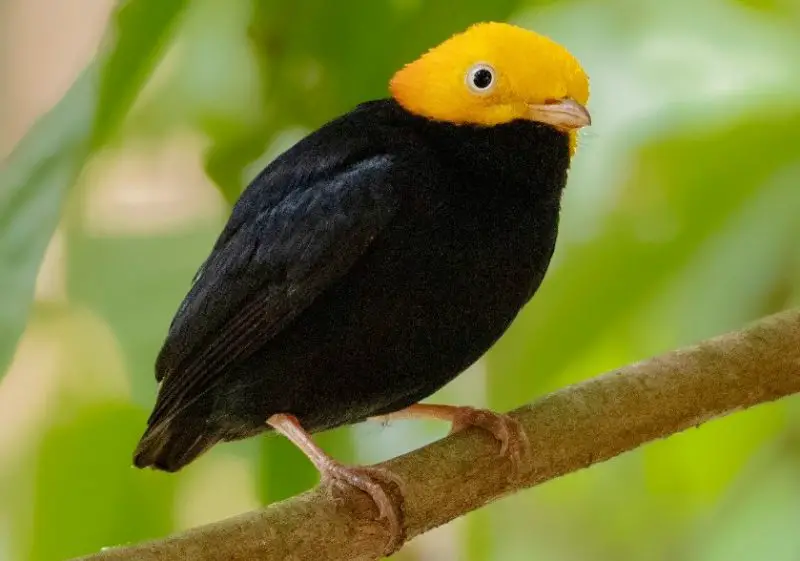
The Golden-headed Manakin (Ceratopipra erythrocephala) is a vibrant and easily identifiable bird. Males are striking with their entirely yellowish-gold heads and jet-black bodies, while females are olive green with pink legs. Measuring 3.1–3.5 inches in length, they are compact with white eyes, making them stand out in their tropical forest habitats.
Golden-headed Manakins are known for their unique mating displays in leks, where males perform acrobatic moves and emit humming sounds to attract females. They thrive in open woodlands and lowland forests and can live up to 8 years.
Golden-winged Cacique
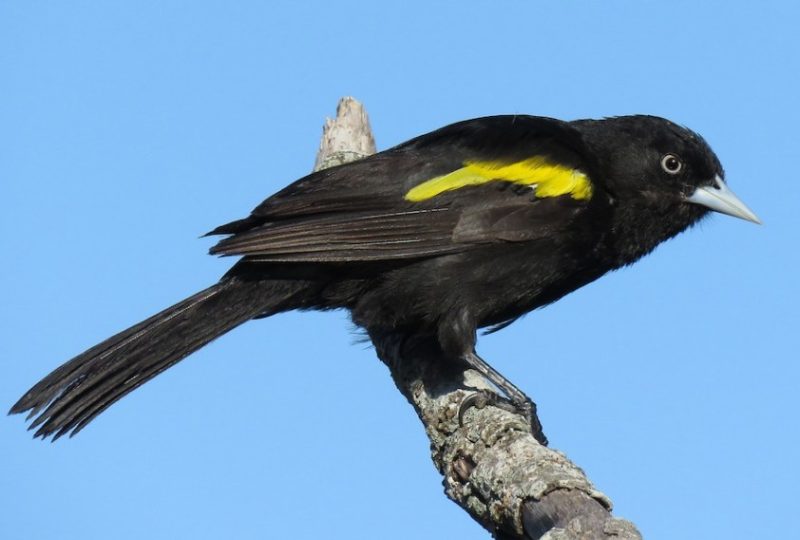
The Golden-winged Cacique (Cacicus chrysopterus) is a striking black bird with distinctive yellow patches on the rump and inner wings. It features white eyes and a pale blue or grey beak, with a black crest that can be displayed upright, adding to its unique appearance. Measuring 7.4–7.8 inches in length with a wingspan of 8–11 inches, these birds are found in montane forests, second-growth forests, and forest edges.
Golden-winged Caciques are known for their hanging, basket-shaped nests and their solitary, monogamous nature. They are year-round residents and prefer humid environments within their range.
Yellow-bellied Siskin
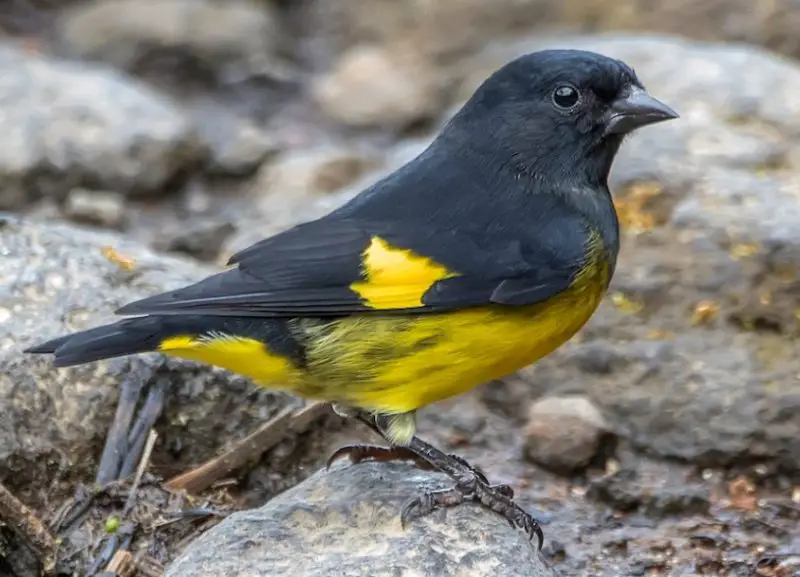
The Yellow-bellied Siskin (Spinus xanthogastra) is a small, striking bird often mistaken for a Lesser Goldfinch. Males are distinguished by their vibrant black and yellow plumage, featuring a broad yellow wing band and entirely yellow belly. They also sport a black throat and upper breast, contrasting with the dull greenish-yellow of females.
Measuring 3.9–4.7 inches in length with a wingspan of 6.7–6.9 inches, these birds are typically found in mountain oak forests and coffee plantations at altitudes ranging from 800 to 3,000 meters. Yellow-bellied Siskins are territorial, and juveniles must establish separate foraging and breeding territories from adults.
Golden-collared Manakin
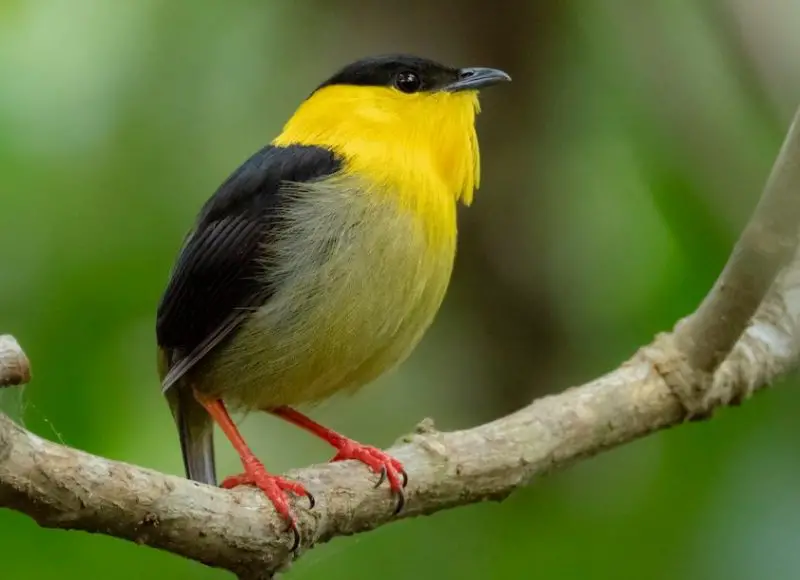
The Golden-collared Manakin (Manacus vitellinus) measures 4–4.3 inches (10–11 cm) in length, weighs 0.5–0.6 oz (14–17 g), and has a wingspan of 5–7 inches (12–17 cm). This vibrant bird features a yellow body with striking black patches on its head, shoulders, wings, and tail. It primarily inhabits tropical and subtropical moist lowland forests but has adapted to disturbed areas like marshes and woodlands.
Males display their colorful plumage to attract mates, although this makes them visible to predators. Once paired, the female builds the nest alone. Notably, Golden-collared Manakins are famous for their unique dance moves, including gliding backward and moonwalking, accompanied by a distinctive “pee-yoo” sound.
Vitelline Masked Weaver
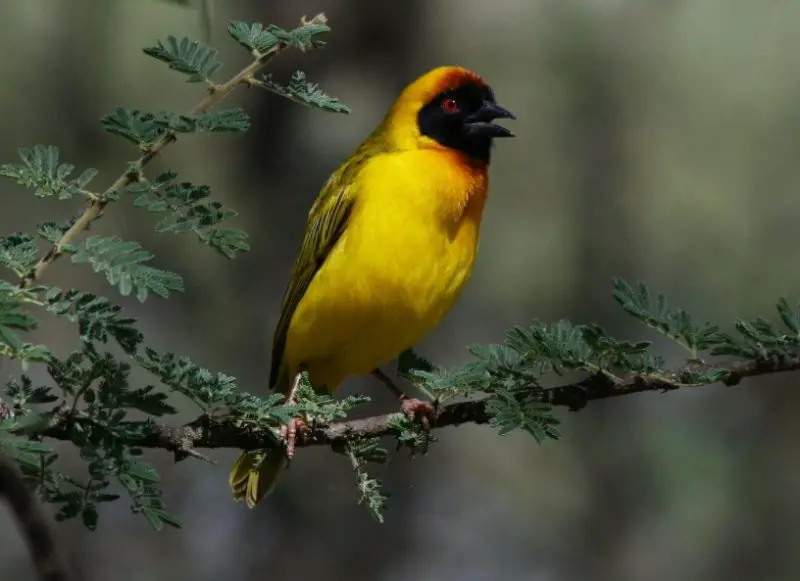
The Vitelline Masked Weaver (Ploceus vitellinus) is a striking bird, measuring 5.5 inches (14 cm) in length and weighing between 0.6 and 0.8 ounces (18–22 g). Males are especially vibrant, with a black face mask that fades into red, contrasted against their bright yellow body.
All individuals feature red eyes and dark, conical bills, with pale black wing markings. These weavers are noted for their unique nesting behavior, constructing intricate, leaf-hung nests in the Sahel’s dry savannah woodlands and scrublands. They can live up to 15 years.
Regent Bowerbird
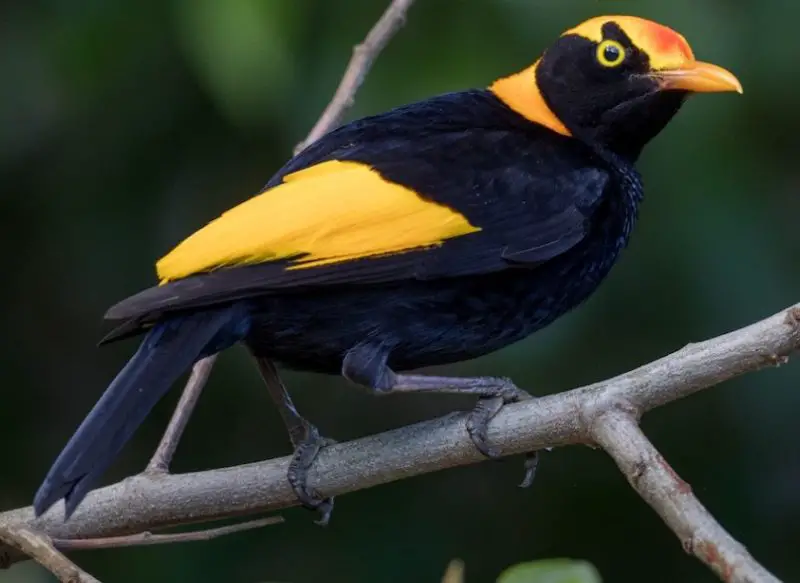
The Regent Bowerbird (Sericulus chrysocephalus) is a striking passerine songbird, measuring 9.8 to 11.8 inches (25–30 cm) in length and weighing around 3.5 ounces (100 g). Its vibrant plumage features a golden yellow crown, nape, eyes, and wing edges, with the rest of the body in shiny black.
Juveniles and non-adult birds lack the bold black and yellow colors, and have brown eyes initially. Regent Bowerbirds are found in landforms created by running water, dense trees, rainforests, and thickets. They build an elaborate bower on the ground, decorated with pea-green saliva to attract females, while the actual nest is constructed above ground. They can live up to 20 years.
Black-headed Weaver
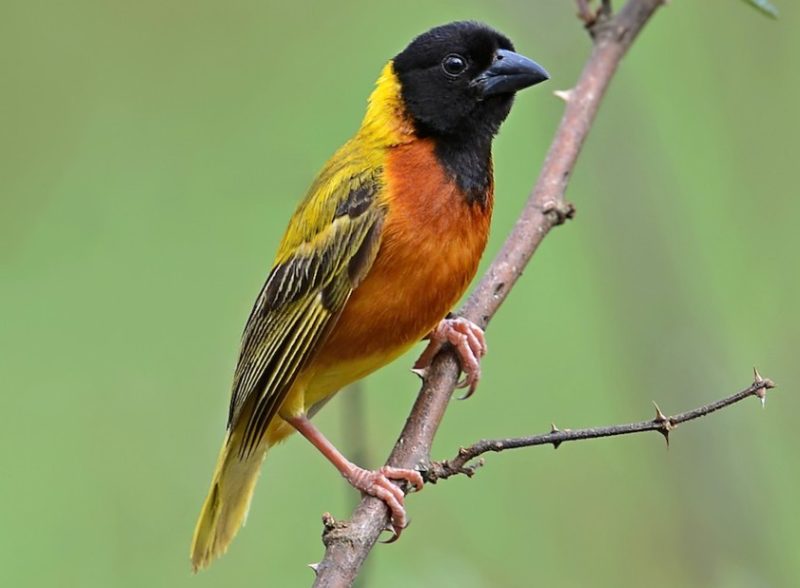
The Black-headed Weaver (Ploceus melanocephalus) is a striking bird, measuring 5.5 inches (14 cm) in length and weighing between 6.6 and 9.8 ounces (17–25 g). Males are distinguished by their black head, chestnut-colored breast, and black markings on their wings and tail, while females have olive-green plumage and lack the black mask.
These birds are commonly found in open acacia woodlands in Africa. During the breeding season, males build elaborate hanging nests and display their craftsmanship to attract females. Black-headed Weavers are social and often forage in groups, flying in close formations and performing intricate maneuvers. They can live up to 15 years.
Speke’s Weaver
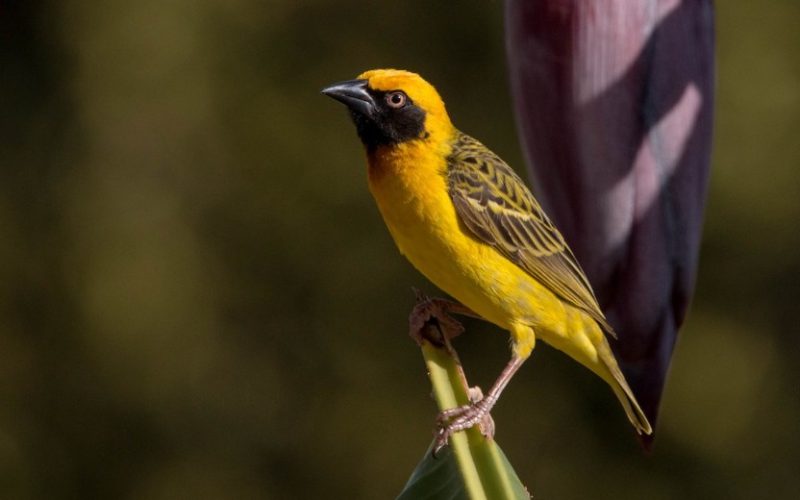
Speke’s Weaver (Ploceus spekei) is a vibrant bird, measuring 5.9 inches (15 cm) in length and weighing between 1.0 and 1.5 ounces (28–43 g). Males are striking with their predominantly yellow plumage, black wing markings, and a distinctive black face mask. They have a relatively short tail and a long beak, with darker plumage and a rusty-edged black throat.
Females are olive-gray with pale yellow underparts and brown streaks, while juveniles have duller colors. Speke’s Weavers prefer farmlands, brushlands, and savannahs near water sources. They are often seen in flocks and are known for their chattering noises in their colonies. These birds can live up to 15 years and are categorized as being of least concern.
American Goldfinch
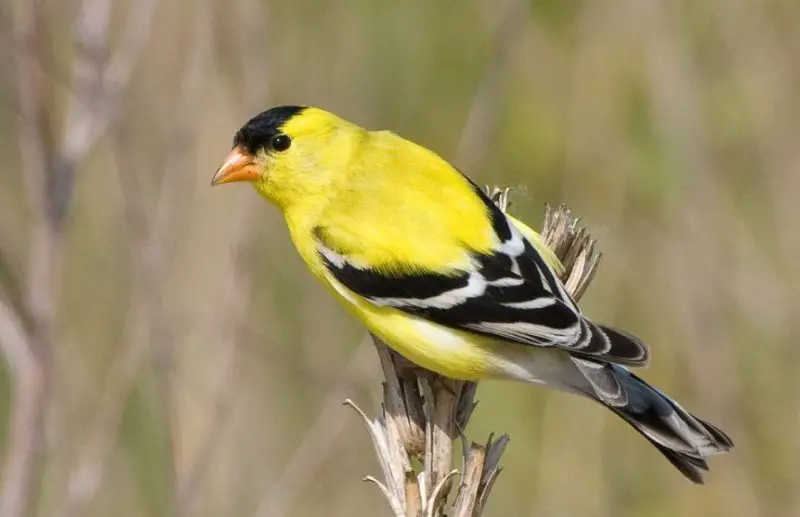
The American Goldfinch (Spinus tristis) is a vibrant yellow bird with striking black wings, tail, and a black forehead, adorned with white markings. This species, with a wingspan of 7.5 to 8.7 inches and a lifespan up to 7 years, exhibits plumage variations based on age and sex.
Females and young goldfinches have greenish-yellow backs and black wings, with immature birds showing brown undertones. Their distinctive short orange bill, small head, and notched tail enhance their unique appearance. Commonly found in areas with asters and thistles, such as floodplains and weedy fields, goldfinches are also attracted to feeders in winter. These territorial birds nest in mid-summer, aligning with peak food availability.
Yellow-headed Blackbird
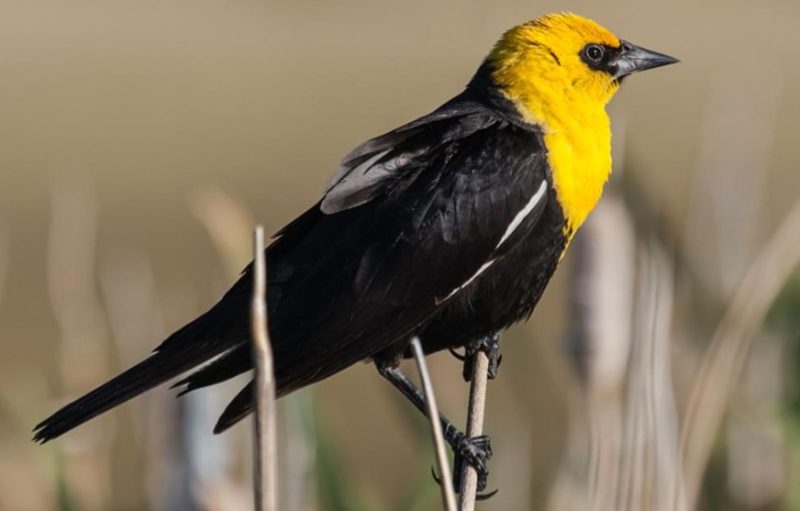
The Yellow-headed Blackbird (Xanthocephalus xanthocephalus) stands out with its vibrant yellow head and deep black body, resembling a bird in a yellow shirt and black jacket. Measuring 8.3 to 10.2 inches in length with a wingspan of 16.5 to 17.3 inches, and weighing between 1.6 and 3.5 ounces, this species has a lifespan of up to 12 years.
Males have a distinctive black eye mask and beak, while females feature similar black plumage with a patchy yellow head. Found in freshwater wetlands with abundant cattails and vegetation, males establish territories and attract up to eight females. While they help with the first brood, subsequent nests are managed by the females alone.
Baya Weaver
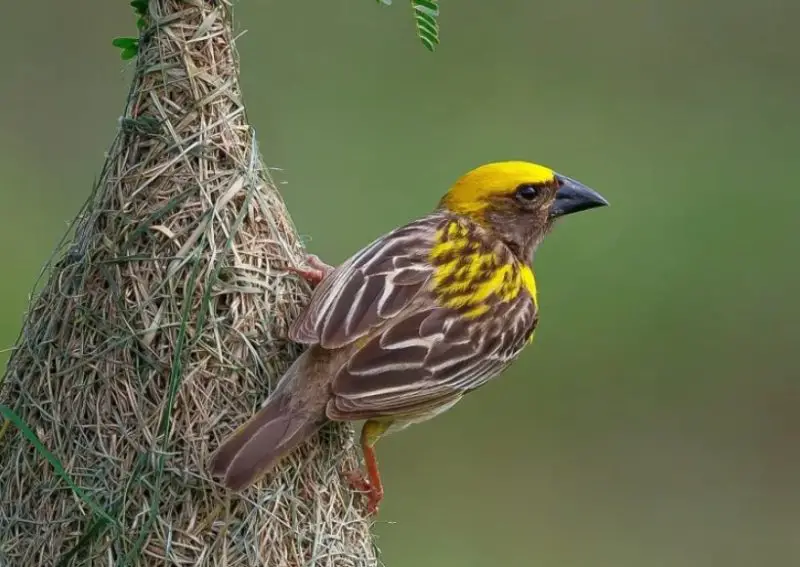
The Baya Weaver (Ploceus philippinus) is a vibrant yellow bird found throughout South and Southeast Asia, measuring about 5.9 inches (15 cm) in length and weighing around 0.9 ounces (28 g). Males are easily identified by their bright yellow bodies and dark brown to black mottled wings, along with their distinctive mask that can be in either shade. The lower underparts are white, contrasting with the yellow upper body, while females are characterized by their pale green plumage.
These sociable birds are often seen in groups in diverse habitats such as grasslands, scrub, secondary growth, and cultivated areas. During the breeding season, they build colonies of nests high off the ground in these environments, reducing the risk of predation. Although they are generally friendly, Baya Weavers can be considered pests in some regions due to their tendency to damage crops, which poses a challenge for farmers.
Himalayan Black-lored Tit
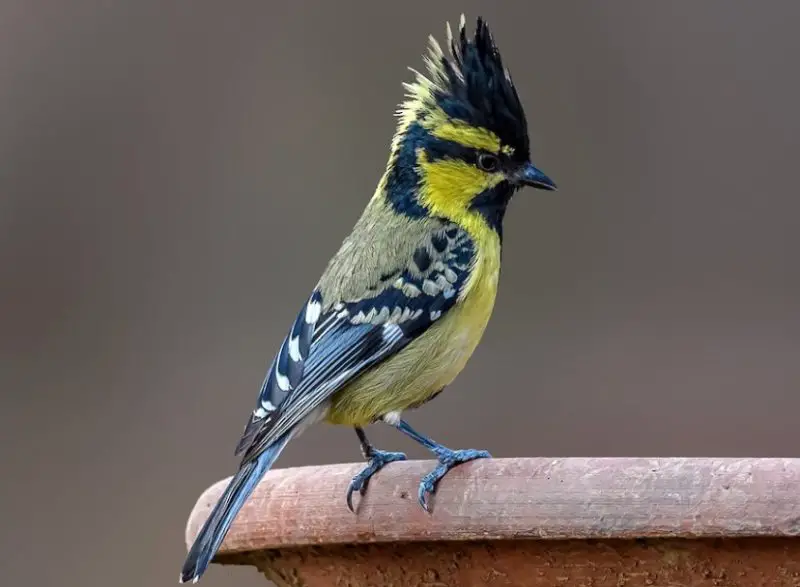
The Himalayan Black-lored Tit (Parus xanthogenys) is a striking bird known for its distinctive crown and vivid plumage. Measuring 5.1 to 5.5 inches (13 to 14 cm) in length and weighing between 0.4 and 0.7 ounces (12 to 20 g), this tit features a striking combination of black and yellow colors. The black covers the crown, eye line, throat, nape, wing panels, and tail, while white and yellow mottling decorates the wings.
These birds thrive in montane forests and foothills, often inhabiting the middle to upper levels of forested areas. Highly social, they are frequently seen in groups and join mixed-species flocks during foraging for insects, fruits, and spiders. Notably practical during the breeding season, Himalayan Black-lored Tits often use and recycle old woodpecker and barbet holes for nesting.
Yellow-crowned Bishop
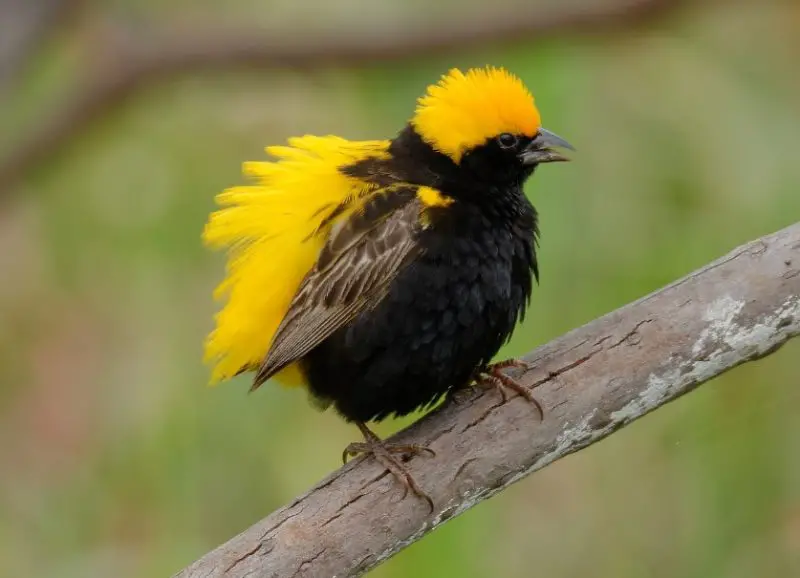
The Yellow-crowned Bishop (Euplectes afer) is a small passerine bird notable for its striking plumage, which varies between sexes. Males, during the breeding season, exhibit bright yellow and black feathers, while females are typically brown and less colorful. Measuring 3.7 to 4.1 inches (9 to 10 cm) in length and weighing between 0.3 and 0.7 ounces (11 to 20 g), these birds also have a wingspan of 4 to 5 inches (10 to 12 cm).
They are commonly found in weedy vegetation, grasslands, and wetlands, where they forage for seeds, grains, and insects. During the non-breeding season, Yellow-crowned Bishops often mingle with weavers and sparrows in their feeding groups. Their lifespan can reach up to 15 years.
Hispaniolan Oriole
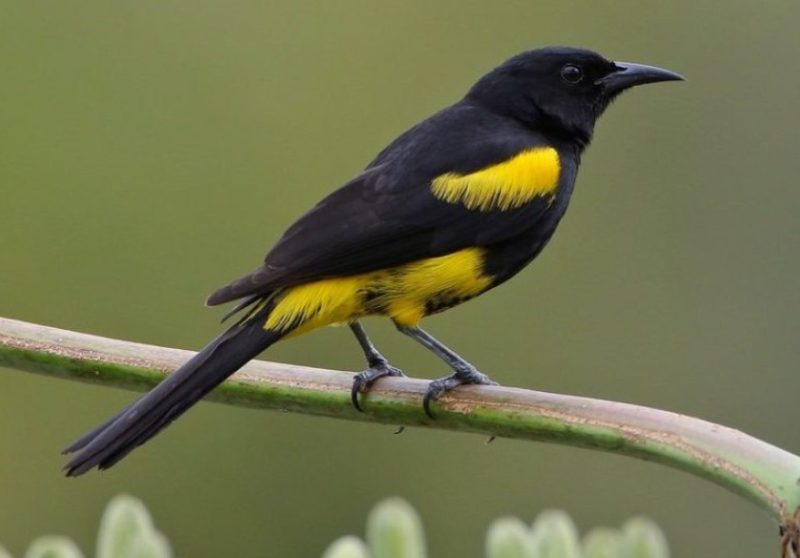
The Hispaniolan Oriole (Icterus dominicensis) is a slender, forest-dwelling bird characterized by its striking black plumage with yellow patches on the lower underparts, rump, wing bar, and thighs. Adults display this vibrant coloration, making them easy to spot in their native habitats of tropical and subtropical forests, woodlands, gardens, and mid-elevation mountains on the island of Hispaniola and nearby regions.
Measuring 7.8 to 8.6 inches (20 to 22 cm) in length, weighing between 1.1 and 1.4 ounces (33 to 40 g), and with a wingspan of 9.8 to 11.0 inches (25 to 28 cm), these birds have a lifespan of up to 11 years. Their diet mainly includes insects, flowers, fruits, and nectar. Hispaniolan Orioles are often seen foraging in dense vegetation, sometimes hanging upside down to reach insects or pecking at hanging fruits.
Citrine Wagtail
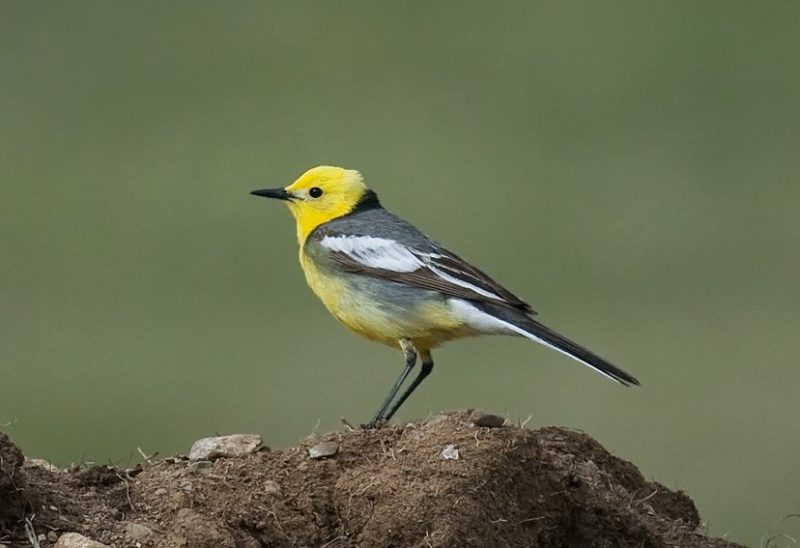
The Citrine Wagtail (Motacilla citreola) is a striking small bird commonly found across Asia. Adults are easily identified by their bright yellow body and contrasting black collar, back, wings, and tail, with white wing bars and tail edges. Male breeding adults display the most intense black coloration.
Measuring 5.9 to 6.7 inches (15 to 17 cm) in length, weighing between 0.5 and 0.8 ounces (15 to 24 g), and with a wingspan of 9.4 inches (24 cm), these birds have a lifespan of up to 2 years. Females are less vivid, with a duller yellow and a black cheek patch, along with grey backs and wings.
Citrine Wagtails are insectivores, often found in wet meadows, willow thickets, bogs, and marshy tundras. They are highly territorial, showing little tolerance for intruders or other wagtails.
Yellow-browed Bulbul
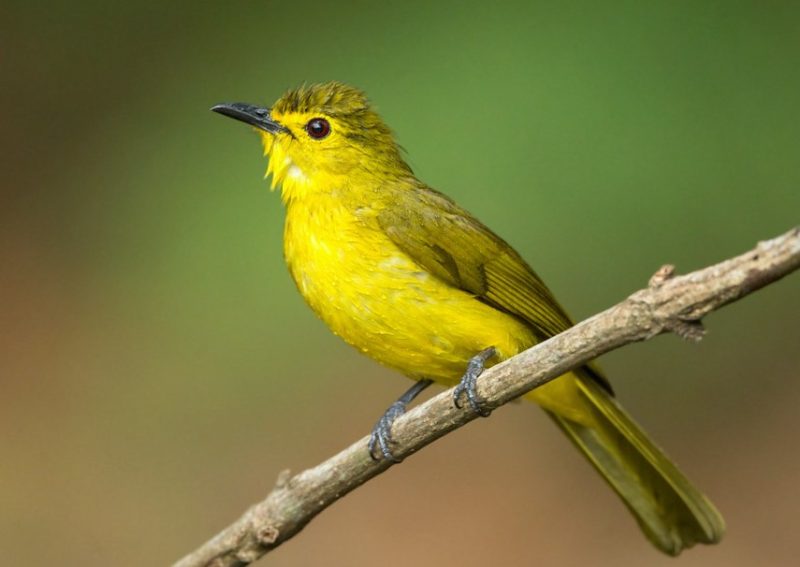
The Yellow-browed Bulbul (Acritillas indica) is a small, vibrant songbird native to Asia, particularly Sri Lanka and southern India. Measuring 5.9 to 6.7 inches (15 to 17 cm) in length, with a weight of 0.5 to 0.8 ounces (15 to 24 g) and a wingspan of 9.4 inches (24 cm), these birds have a lifespan of up to 2 years.
They are distinguished by their yellow and yellowish-green bodies, accented with black patches on the wing tips and tail. The gradient on the wing panels can give an olive-green appearance, qualifying them as black and yellow birds.
Yellow-browed Bulbuls are typically found in forests, plantations, and sometimes join mixed-species flocks. Their whistle-like calls and sharp “pick-wick” notes are useful for locating them, especially during the breeding season.
Flame-throated Bulbul
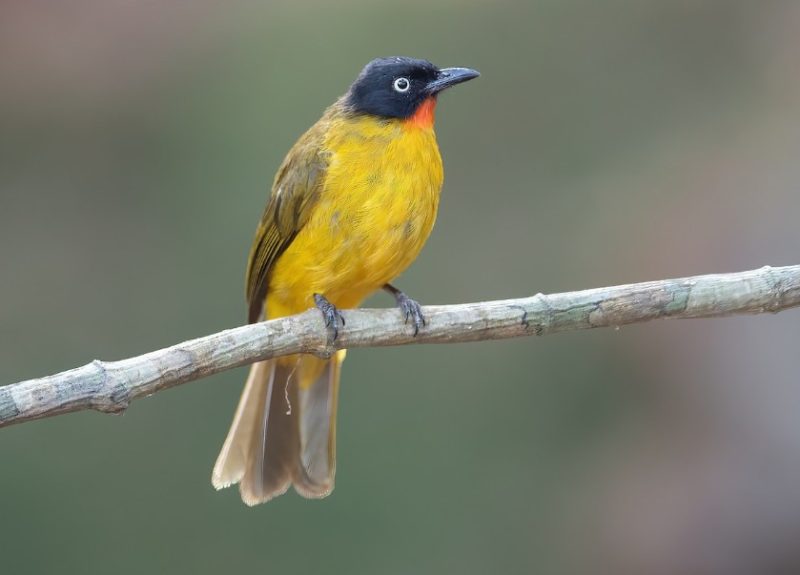
The Flame-throated Bulbul (Rubigula gularis) is a striking bird known for its vibrant coloration. Measuring 7 to 7.4 inches (18 to 19 cm) in length, weighing 0.8 to 1.2 ounces (25 to 35 g), and with a wingspan of 8 to 10 inches (20 to 25 cm), it can live up to 14 years.
This species is easily recognizable by its black head, bright yellow underparts, and a distinctive fiery red throat. Its pale white eyes starkly contrast with the dark head and bill. Although juvenile appearances are not well-documented, the adult Flame-throated Bulbul’s vivid colors make it a standout.
You can find these birds in deep forests, coffee plantations, or forest edges, often in small groups with their kind or mixed-species flocks. They are also seen near valleys or streams, foraging for food.
Townsend’s Warbler
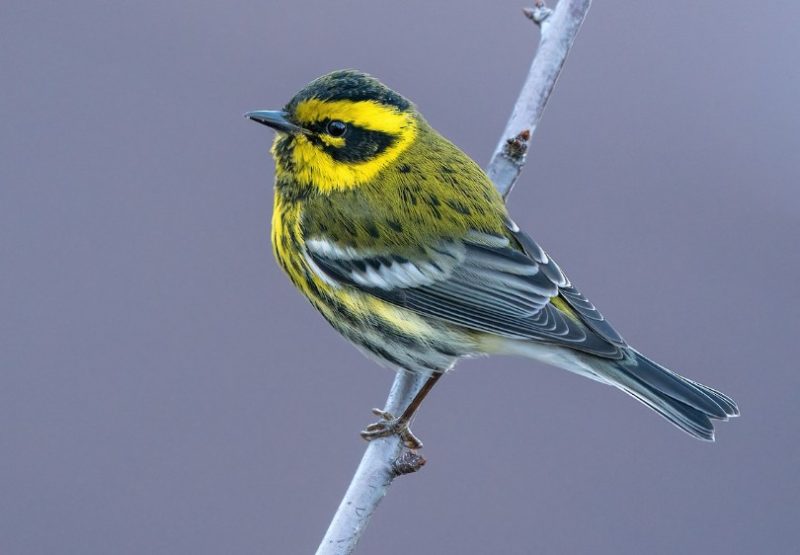
The Townsend’s Warbler (Setophaga townsendi) is a small, striking songbird that stands out with its yellow and black plumage. Measuring 4.7 to 5.0 inches (12 to 12.7 cm) in length, weighing 0.3 to 0.4 ounces (7.3 to 10.4 g), and with a wingspan of 7.5 to 8.3 inches (19 to 21 cm), it can live up to 10 years.
This warbler features a distinctive black-striped head with a horizontal half-moon eye mask, and similar markings extend across its throat, wings, back, and tail. While females have similar patterns, they are less pronounced than those of males.
Townsend’s Warblers are typically found gleaning insects and spiders from the foliage of coniferous and deciduous trees. In winter, they join mixed-species flocks in California, Central America, and Mexico. Known for their territorial behavior, these warblers are particularly protective of their nesting sites and the surrounding food resources.
Golden-winged Sunbird
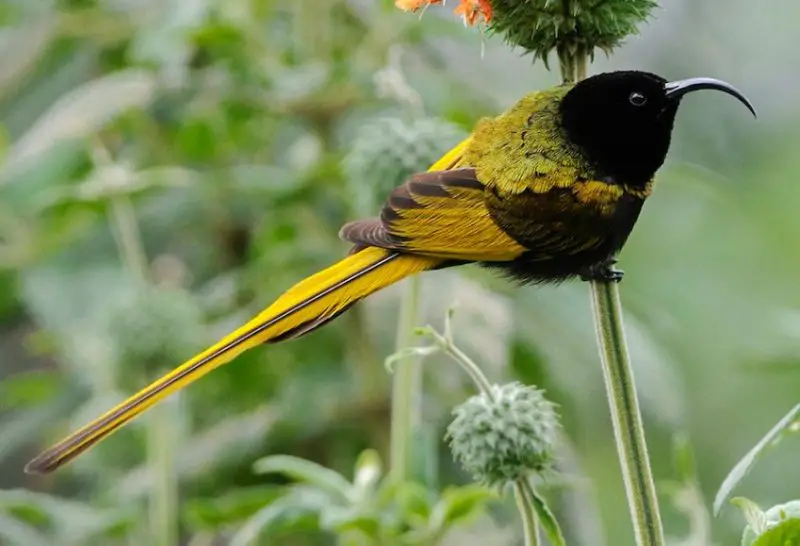
The Golden-winged Sunbird (Drepanorhynchus reichenowi) is a vibrant yellow and black bird with a distinctive appearance. Ranging from 6 to 9 inches (15 to 22 cm) in length and weighing between 0.3 and 0.6 ounces (11 to 17 g), these sunbirds can live up to 22 years.
Breeding males are notable for their striking black head, back, and wings, contrasted by bright yellow areas on their body. Females, however, exhibit less intense black patches.
These sunbirds are found in cultivated areas, bamboo forests, tall grasslands, and forest edges across Congo, Tanzania, Kenya, Uganda, and the Democratic Republic of Congo. Known for their nomadic behavior, they move in search of food, particularly favoring Leonotis nepetifolia flowers, which they defend aggressively during their limited blooming period in July.
Sooty-Capped Bush-Tanager
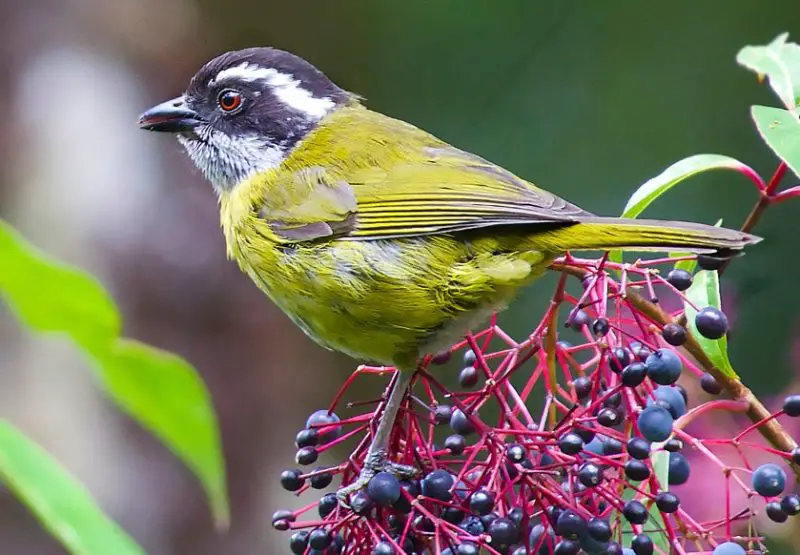
The Sooty-Capped Bush-Tanager (Chlorospingus pileatus) is a small, stout bird measuring about 5.3 inches (13.5 cm) in length and weighing 0.7 ounces (20 g). Its distinct appearance features a predominantly black head with white vertical streaks above the eyebrows and throat, contrasting with its yellow breast and underparts. The back and wings transition to an olive-green hue.
Endemic to Panama and Costa Rica, these tanagers are found in bushy clearings, montane forests, and second-growth habitats. They are lively foragers, seeking fruits, insects, and spiders in groups with other bird species. Despite their active nature, little is known about their breeding behavior.
Great Hornbill
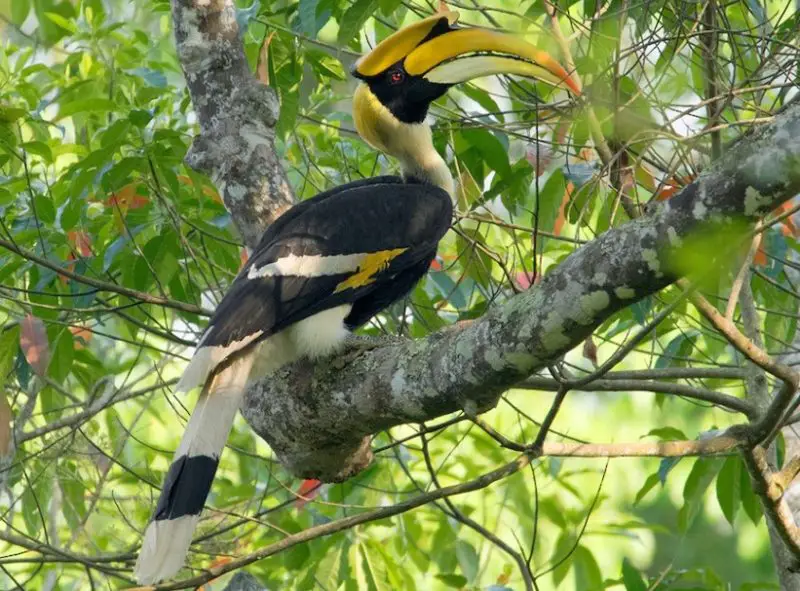
The Great Hornbill (Buceros bicornis) is a strikingly large bird, measuring 38 to 47 inches (96 to 119 cm) in length and weighing between 75.1 and 140.7 ounces (2,131 to 3,991 g). Its notable features include a curved, colorful beak and black and yellow plumage with white markings on the tail and wing bar.
These birds inhabit forests and are typically found perched on fruit-bearing trees. Their diet consists mainly of raw fruits, nuts, seeds, shoots, and roots, but they will also hunt reptiles, small mammals, and birds. When consuming prey, they tear it apart before tossing it into the air to catch with their large beak.
Great Hornbills are most active during the day, foraging in open areas with minimal foliage. They can be quite loud, especially when gathered in communal roosts. Despite their impressive size and adaptations, they are currently classified as Vulnerable due to habitat loss and other threats.
Bokmakierie Shrike
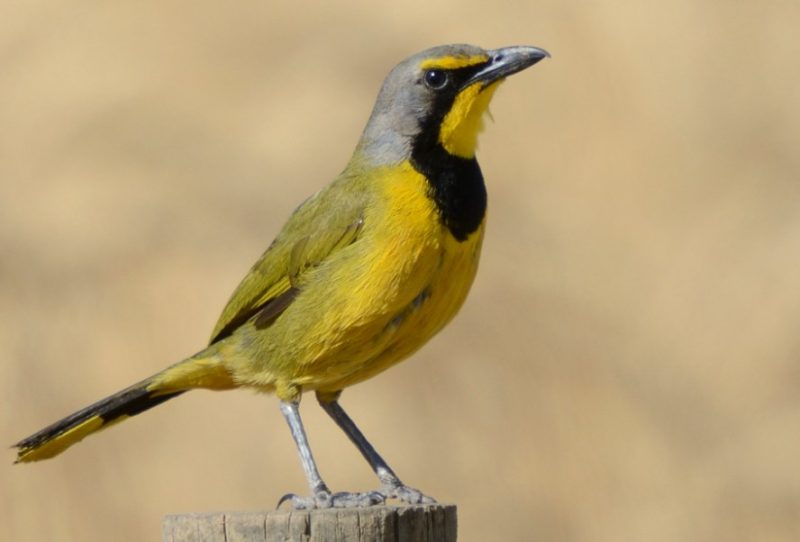
The Bokmakierie Shrike (Telophorus zeylonus) is a bird with distinctive tri-colored plumage, featuring a black marking that extends from its cheeks to its breast, yellow eyebrows, and a grey crown. Their bodies are adorned with a mix of grey and yellow, although young birds and females exhibit less vibrant colors compared to the striking hues of adult males.
Measuring 8.6 to 9 inches (22 to 23 cm) in length and weighing 2.2 to 2.3 ounces (65 to 68 g), the Bokmakierie Shrike prefers open habitats such as gardens, parks, urban areas, and fynbos. These birds are typically seen in pairs or small groups, particularly during breeding season. They are known for their shy nature and limited interaction with other bird species, especially bush shrikes.
Common Yellowthroat
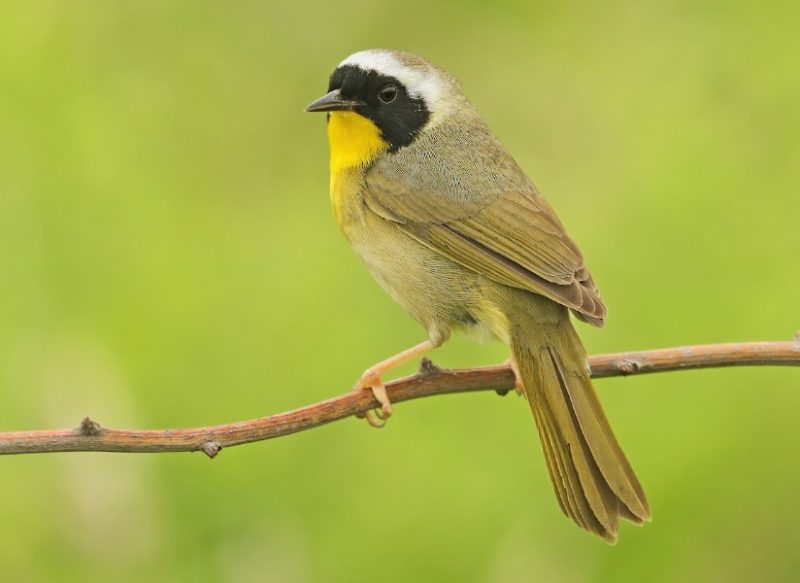
The Common Yellowthroat (Geothlypis trichas) is a small songbird, measuring 4.3 to 5.1 inches in length with a wingspan of 5.9 to 7.5 inches, and weighing between 0.3 and 0.4 ounces. This species, with a lifespan of up to 11 years, is known for its striking appearance: a round head with a black face and vibrant yellow plumage extending from the chin to the breast. The rest of the body features a blend of yellow and black, creating a greenish hue.
Females share a similar color pattern but with paler dark areas and a thin white line around their black eye mask. Common Yellowthroats are found year-round in marshes, pine forests, and grasslands with low vegetation.
During the breeding season, they establish territories in these food-rich areas. Observing their aggressive behavior during birdspotting led to the discovery that their black masks can trigger male rivalry, a signal of competition within the species.
Lesser Goldfinch
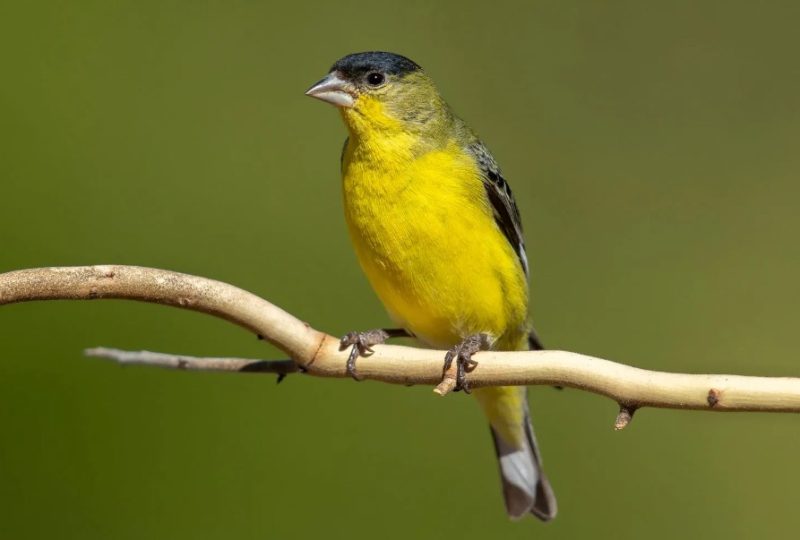
The Lesser Goldfinch (Spinus psaltria) is a small bird measuring 3.5 to 4.3 inches in length with a wingspan of 5.9 to 7.9 inches and weighing between 0.3 and 0.4 ounces. With a lifespan of up to 6 years, this species resembles the American Goldfinch but is distinguished by its black cap instead of a black forehead.
Depending on their region, Lesser Goldfinches may have a dull green or black back, with Rocky Mountain and South and Central American populations exhibiting solid black backs and vivid yellow underparts.
These birds have a stubby bill, long, pointed wings, and a notched tail. They prefer areas with abundant food, such as weedy fields and treetops, and often form large, gregarious flocks of over a hundred members.
Scott’s Oriole
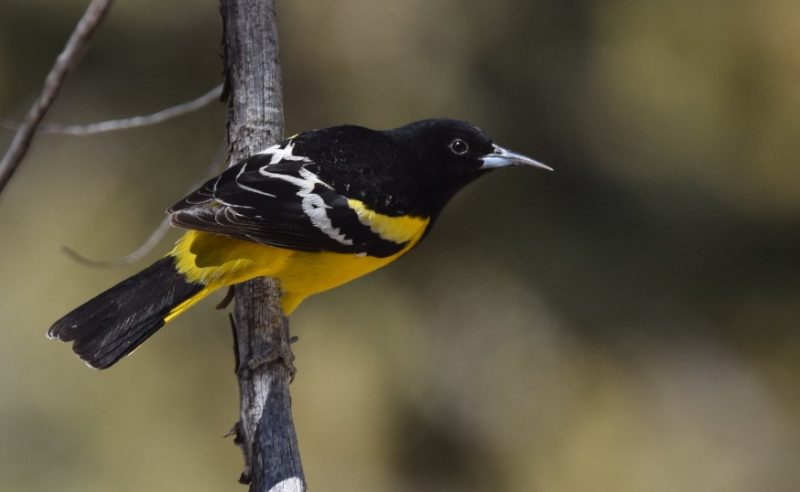
Scott’s Oriole (Icterus parisorum) is a striking bird, measuring 9.1 inches in length with a wingspan of 12.6 inches and weighing between 1.1 and 1.4 ounces. With a lifespan of up to 6 years, this oriole is easy to spot due to its black head and breast contrasting with a lemon yellow belly and rump. It features a sturdy build and a sharp, straight bill.
Females have a greenish-brown appearance due to their washed-out plumage, while immature males have darker, paler backs. Scott’s Orioles forage and nest in mountains, open areas, and occasionally cactus deserts, displaying territorial behavior based on food availability, especially nectar from yuccas.
Eastern Meadowlark
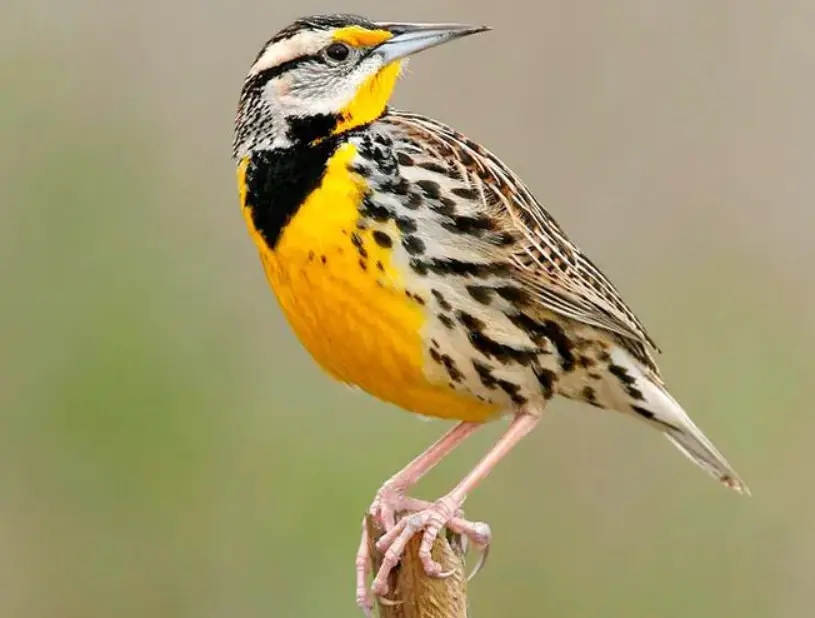
The Eastern Meadowlark (Sturnella magna) is a robust songbird with a striking appearance: a yellow chest, brown upper parts with black markings, and a distinctive black V-shaped patch on its neck. Measuring 8.7 to 11.0 inches in length with a wingspan of 13.8 to 15.8 inches and weighing 3.1 to 4.1 ounces, this bird also has white patches on the upper eyelid and lower cheeks and white feathers on the tail.
Typically found in meadows, wetlands, and grasslands, Eastern Meadowlarks are known for their melodious songs during spring, often perched on treetops, utility lines, or fence posts. Males are polygynous, accepting 2 to 3 females in their territory, while females typically have one mate and may return to the same territory if the male remains.
Evening Grosbeak
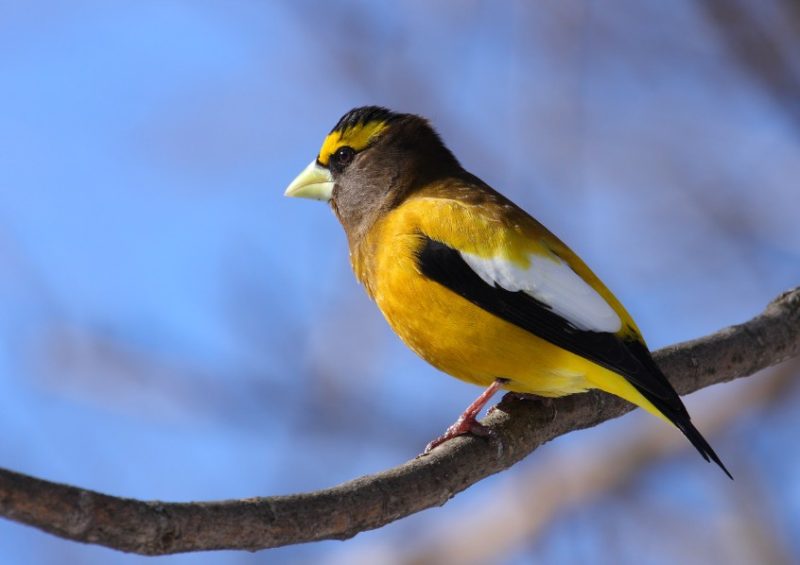
The Evening Grosbeak (Coccothraustes vespertinus) is a striking bird, with males displaying vibrant black and yellow plumage, while females have a greenish-yellow tinge. Measuring 6.3 to 7.1 inches in length with a wingspan of 11.8 to 14.2 inches and weighing 1.9 to 2.6 ounces, these birds can live up to 16 years.
They are heavy-set with thick necks and short tails, and are often seen in flocks perched on coniferous trees. During winter, males tend to drive immatures and females away from feeders, but this behavior lessens during the breeding season when food is more plentiful.
Hooded Warbler
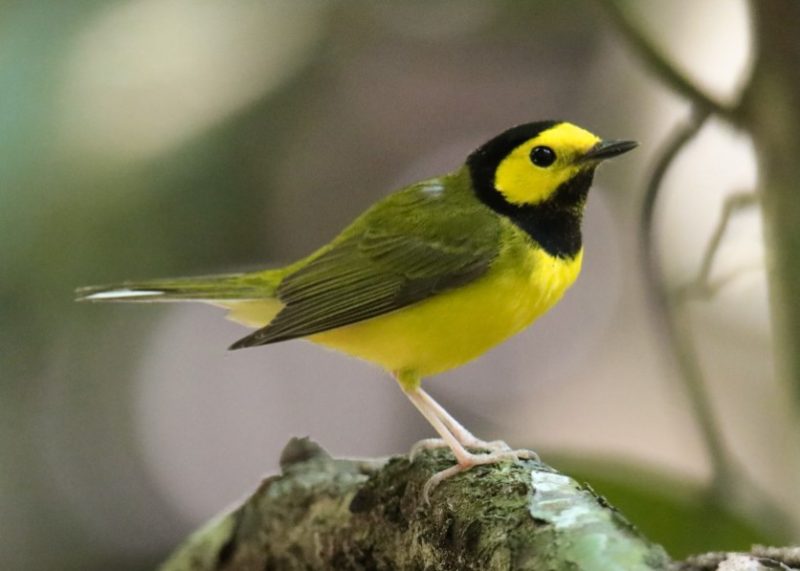
The Hooded Warbler (Setophaga citrina) is a small, striking bird with yellow underparts and a charcoal black “hood” on its head, while its back is a greenish hue. Measuring 5.1 inches in length with a wingspan of 6.9 inches and weighing 0.3 to 0.4 ounces, these warblers can live up to 9 years.
Females and immatures have less black plumage. Hooded Warblers are more heavy-bodied compared to other warblers and feature a sleek, black bill and thick neck.
During breeding season, they are found in the understories of mature forests and woodlands, where they maintain a territory with a single female but may seek extra-pair copulations. They are also susceptible to nest parasitism by brown-headed cowbirds.
Prairie Warbler
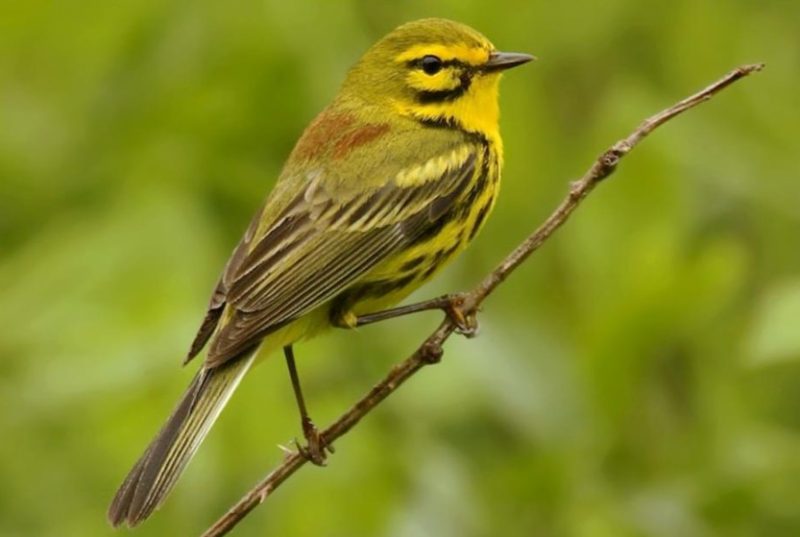
The Prairie Warbler (Setophaga discolor) is a small, vibrant songbird with yellow plumage and distinctive black stripes, more pronounced in adult males than in females and juveniles. Measuring 4.75 inches in length with a wingspan of 5.9 to 7.5 inches and weighing 0.27 ounces, these warblers can live up to 10 years.
They have a chunky build with a long tail and legs but a short neck. Prairie Warblers blend well with their surroundings, making them more visible up close as they flit through woodlands, overgrown pastures, and pine stands.
Found in Florida, Nebraska, and the West Indies, they are socially monogamous, isolating during breeding but becoming more social during migration. They sing two distinct songs—one for courtship and another for marking territory.
Western Tanager
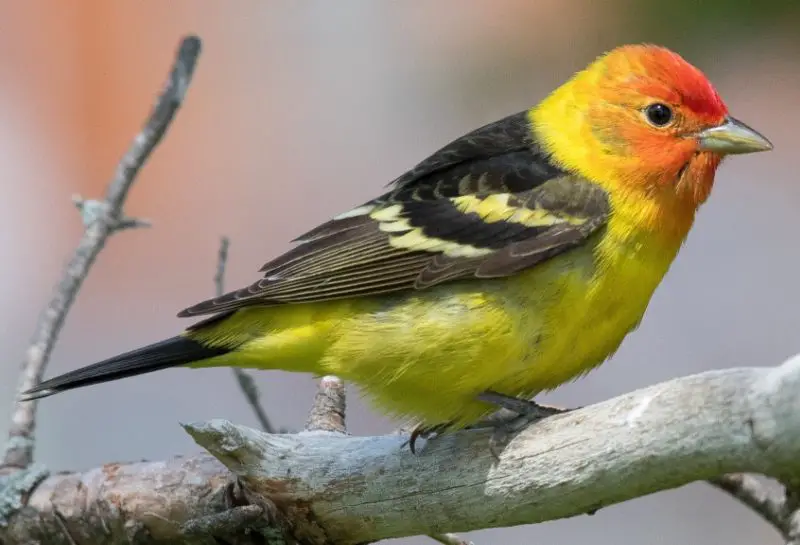
The Western Tanager (Piranga ludoviciana) is a colorful bird, measuring 6.2 to 7.4 inches in length with a wingspan of 11.5 inches and weighing 0.8 to 1 ounce. With a lifespan of up to 15 years, males in breeding plumage are distinguished by their vibrant black and yellow feathers and an orange gradient mask on their face, while non-breeding males also exhibit black and yellow coloration.
Females are typically pale or greenish-yellow with black and yellow wings and backs. Stocky and larger than a typical warbler, Western Tanagers have a short bill and a notched tail. They prefer breeding in coniferous forests, such as those with pine or redwood trees, and forage quietly for insects among tree branches and plants. They also display territorial behavior.
Variable Oriole
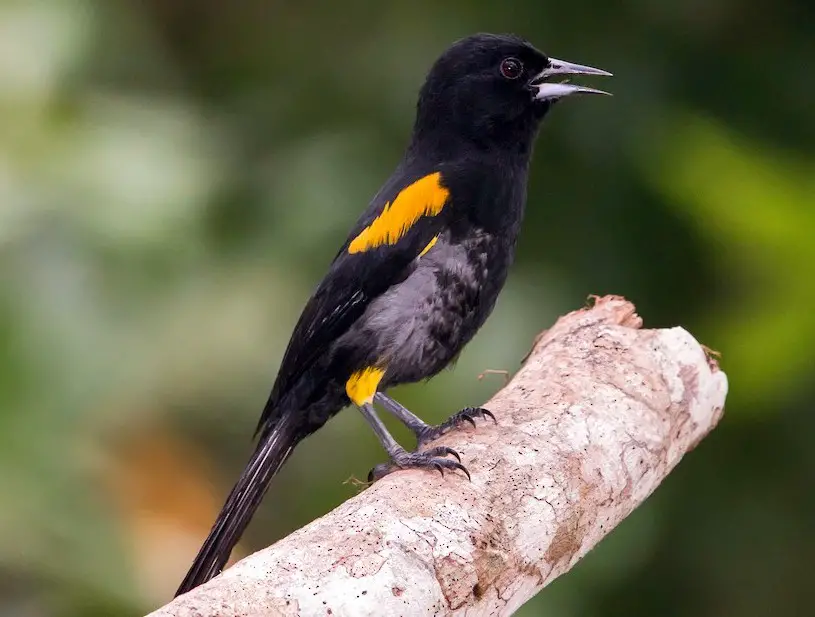
The Variable Oriole (Icterus pyrrhopterus) is a striking bird, measuring 7.8 inches (20 cm) long and weighing 1.1–1.2 ounces (30–33 g). It features jet-black plumage with yellow markings on the wing bar and thighs, and a pale patch on its belly. Its head is large with dark brown eyes, and the tail may have subtle white lines on the edges.
Found in wooded savannas, forest edges, gardens, and urban parks, these birds are known to visit fruit trees and flowers. While their behavior remains less documented, they are social with other bird species during the non-breeding season. They can live up to 11 years.
Lesser Masked-Weaver
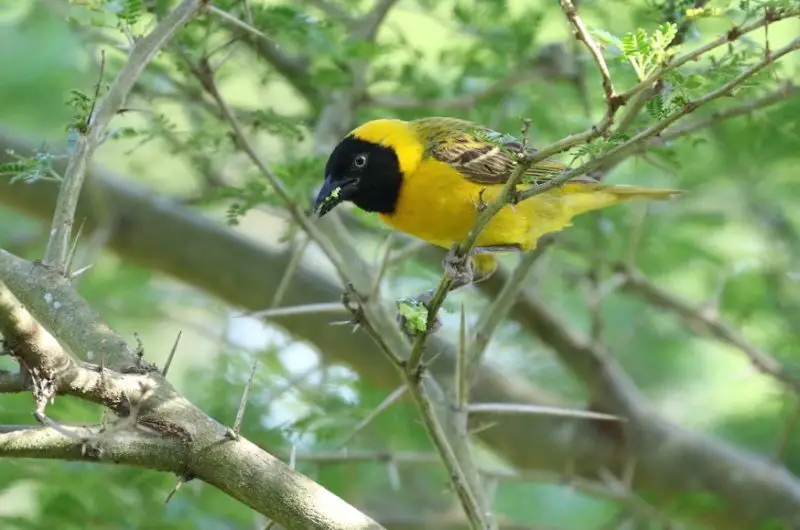
The Lesser Masked-Weaver (Ploceus intermedius) is a striking bird with its yellow body and black face mask. It measures 6–7 inches (15–17 cm) in length, weighs 0.6–0.9 ounces (17–27 g), and has a wingspan of 8–15 inches (20–38 cm). Its black mask extends from the crown to the edge of the cheeks and throat, while the wings and tail are mottled brown and the back is yellowish-black.
These birds prefer wooded savannas and thickets for breeding, forming colonies that can attract parasites. Notably, the Diederik Cuckoo often lays its eggs in Lesser Masked-Weaver nests, leading the host birds to raise the cuckoo’s young unknowingly.
New Holland Honeyeater
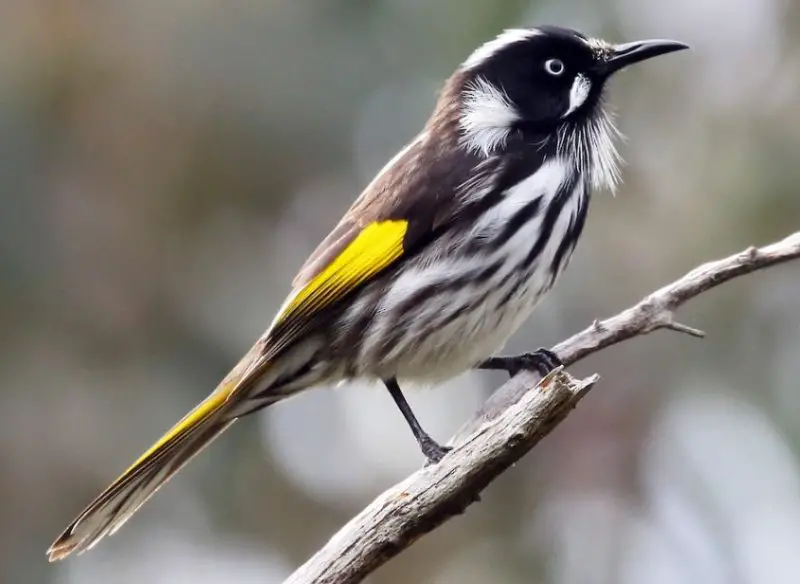
The New Holland Honeyeater (Phylidonyris novaehollandiae) is a small, striking bird with distinctive black and yellow plumage. Measuring 7.1 inches (18 cm) in length and weighing between 0.3–0.8 ounces (10–25 g), it has a wingspan of 9 inches (23 cm). From above, its black back contrasts sharply with the yellow wing and tail panels, while white streaks adorn its underparts.
These birds can be recognized by their pale white eyes and bearded appearance. They thrive in forests, woodlands, gardens, and heaths, feeding on honeydew, manna, insects, and nectar. Often found foraging in flowering spider flowers or banksias, they sometimes join other honeyeaters in their quest for food.
Hooded Siskin
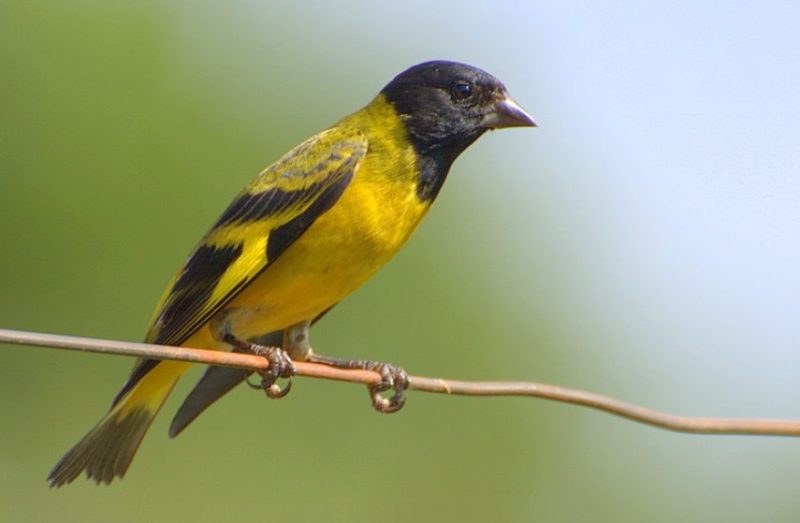
The Hooded Siskin (Spinus magellanicus) is a striking passerine bird characterized by its vivid yellow and black plumage. Males are easily recognizable with their black hoods, which cover the head, nape, throat, and upper breast, while their bodies are primarily yellow with olive-green streaks on the upper parts. Females, in contrast, lack the hood and are more subdued, with an olive-green tint.
Measuring 3.9–5.5 inches (10–14 cm) in length and weighing 0.3–0.4 ounces (11–15 g), Hooded Siskins have a wingspan of 7.8–9 inches (20–23 cm). These gregarious birds are found in savannas, scrublands, farmlands, gardens, and parks, where they forage for insects, seeds, and leaves. They typically form mixed-species flocks but may exhibit territorial behavior during the breeding season.
Southern Masked Weaver
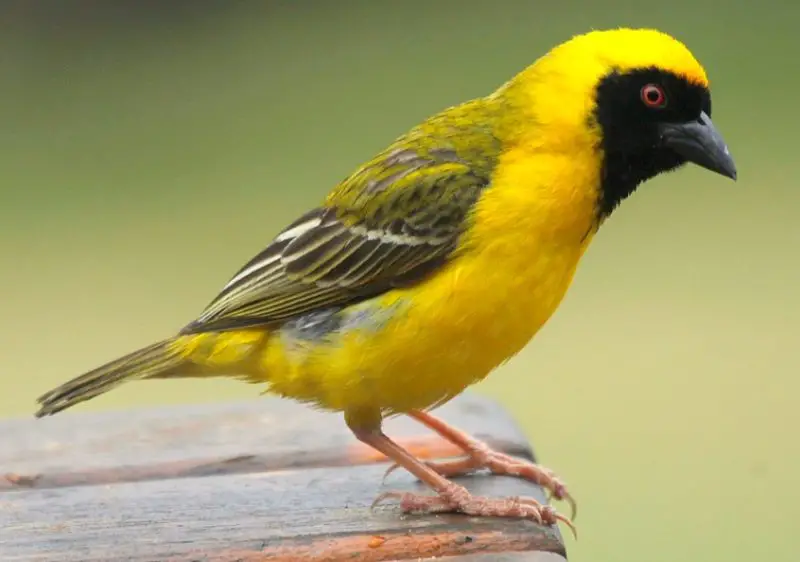
The Southern Masked Weaver (Ploceus velatus) can be challenging to distinguish from other weavers due to its similar features. Males and females both showcase a black mask and mottled wings and tails, but the Southern Masked Weaver is identifiable by its red eyes, green back, and pinkish-brown legs. The mask covers only part of the face, extending narrowly across the forehead, while the underparts are yellow with olive-green streaks on the nape.
These birds measure 4.3–5.7 inches (10–14 cm) in length, weigh 0.8–1.1 ounces (25–34 g), and have a wingspan of 8–15 inches (20–38 cm). They inhabit a diverse range of environments, including savannas, open woodlands, shrublands, wetlands, and even deserts. Occasionally, they are found in parks and gardens. Southern Masked Weavers are social and often forage in flocks, particularly in the morning, and are usually seen with other seed-eating birds.
Village Weaver
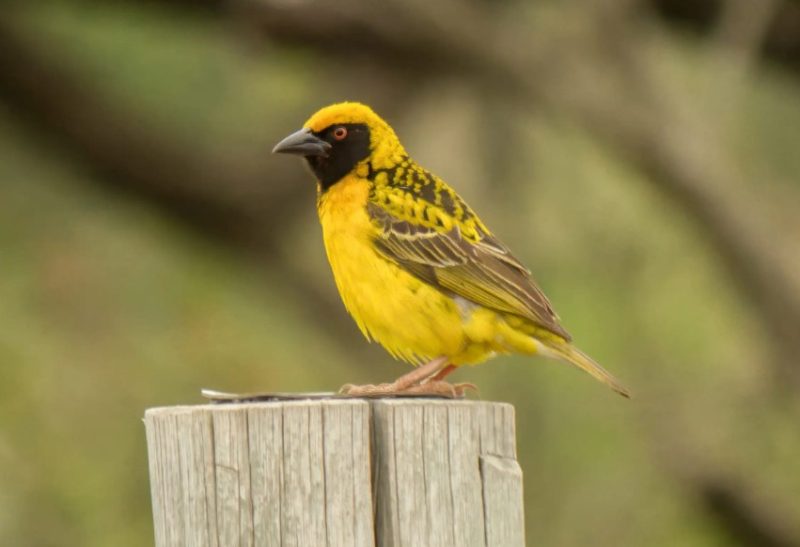
The Village Weaver (Ploceus cucullatus) is a familiar sight in many regions, easily recognized by its spherical head, slender build, and vivid color patterns. Males display a striking combination of black and yellow, with a black mask that extends narrowly down to the throat. Their wings and tail are mottled black, contrasting with their bright yellow underparts and brownish-pink feet. Females, on the other hand, are greenish-yellow to olive-green.
Measuring 7 inches (17 cm) in length and weighing 1.2 ounces (34 g) with a wingspan of 10 inches (25.4 cm), these birds thrive in open woodlands, savannahs, gardens, and fields. They build hanging nests from leaves in colonies, and their distinctive chut-chit calls are a common sound during the breeding season. The Village Weaver has a lifespan of up to 5 years and is known for its active and social nature.
Golden-crested Myna
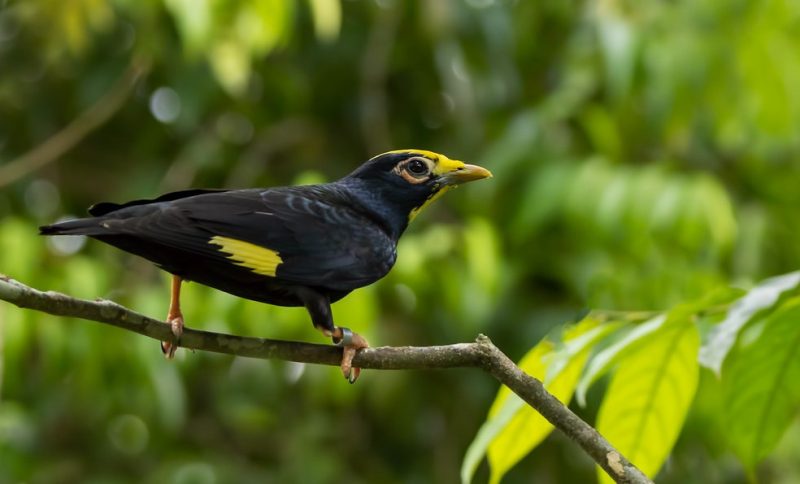
The Golden-crested Myna (Ampeliceps coronatus) is a striking bird known for its vivid yellow and black coloration. Measuring 7.4 to 8.2 inches (19–21 cm) in length and weighing between 2.7 and 3.4 ounces (78–99 g), this myna species features glossy black plumage with a distinctive bright yellow crest on its head. The yellow hue also appears on its wing panels, though the extent of coverage varies among individuals.
Found in lowland evergreen forests, mixed woodlands, and deciduous forests, Golden-crested Mynas are often seen in pairs foraging for small fish, lizards, insects, fruits, and grains. Their population is declining due to habitat destruction and fragmentation. They have a lifespan of up to 20 years, making them a long-lived species within their family.
Yellow-mantled Widowbird
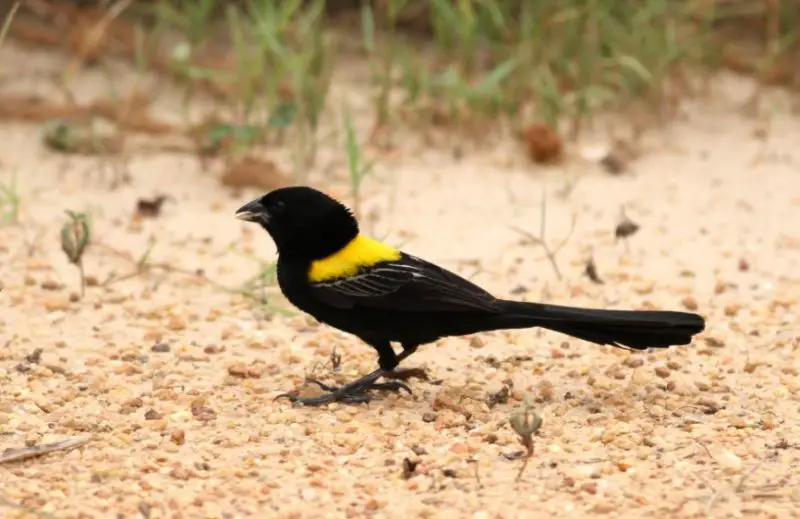
The Yellow-mantled Widowbird (Euplectes macroura) is a striking small bird known for its vivid black and yellow plumage and long tail. Measuring about 5.5 inches (14 cm) in length and weighing between 0.5 and 1 ounce (17–29 g), these birds exhibit regional variations in their yellow coloring, with some showing a yellow back while others have it only on their shoulders.
Females and non-breeding males are generally brown with streaks, contrasting with the vibrant colors of breeding males. The Yellow-mantled Widowbird inhabits cultivation areas, marshes, grasslands, and abandoned farmlands.
Polygynous in nature, males can have up to five females per breeding season and are known for their territorial behavior. Interestingly, males with longer tails are more successful in maintaining their territories, though this trait does not influence female attraction.
Streaked Weaver
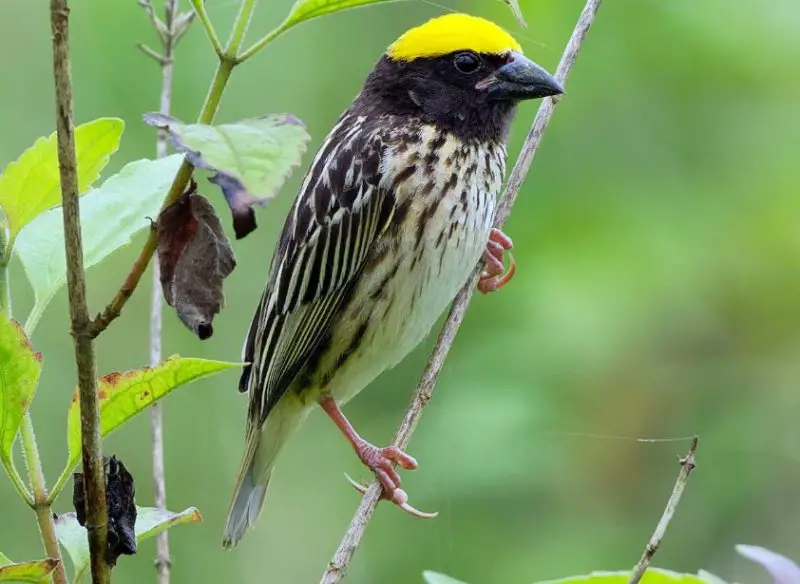
The Streaked Weaver (Ploceus manyar) is a striking yellow and black bird, measuring about 5.5 inches (14 cm) in length and weighing between 0.5 and 0.7 ounces (16–22 g). Males in breeding plumage are distinguished by their yellow crowns and blackish faces and throats, with a mottled appearance as the colors blend into the yellow on their backs, wings, and tails. Dark longitudinal streaks adorn the upper breast and taper off towards the lower underparts. Their pinkish feet add to their colorful appearance.
Streaked Weavers are often found in wetlands, bulrushes, rice paddies, and reedbeds. These sociable birds typically live in flocks and colonies with other weaver species. Known for their noisy behavior and unique ability to hang upside down, they are not solitary nesters and are frequently observed in large, lively groups.

